This article was originally published by The conversation. The publication contributed the article to Space.com’s Expert Voices: Tutorial & Insights.
In May 2020, some unusual rocks containing distinctive green crystals were discovered in the sand sea of Erg Chech, a dune-filled region of the Sahara Desert in southern Algeria.
On close inspection, the rocks came out of outer space: lumps of rubble billions of years old, left over from the beginning of the solar system.
They were all pieces of a meteorite called Erg Chech 002, which is the oldest volcanic rock ever found, having melted long ago in the fires of some ancient, now extinct protoplanet.
In new research published in Nature Communications, we analyzed lead and uranium isotopes in Erg Chech 002 and calculated that it is 4.56556 billion years old, give or take 120,000 years. This is one of the most accurate ages ever calculated for an object from space – and our results also cast doubt on some common assumptions about the early solar system.
Related: The world’s 1st ‘boomerang rock’ — a rock that left Earth, spent thousands of years in space, and returned — may have been found in the Sahara Desert
The secret life of aluminum
About 4.567 billion years ago, our Solar System formed from a giant cloud of gas and dust. Among the many elements in this cloud was aluminum, which came in two forms.
It is the first stable form, aluminum-27. The second is aluminum-26, a radioactive isotope produced primarily by exploding stars, which decays over time to magnesium-26.
Aluminum-26 is a very useful material for scientists trying to understand how the Solar System formed and evolved. Because it disappears over time, we can use it to map events – especially within the first four to five million years of the Solar System’s life.
The aluminum-26 decay is also important for another reason: we think it is the main source of heat in the early Solar System. This decay affected the melting of the small primitive rocks that later coalesced to form the planets.
Uranium, lead and age
However, to use aluminum-26 to understand the past, we need to know whether it was spread around evenly or more closely together in some places than others.
To figure that out, we’ll need to more precisely calculate the absolute ages of some ancient space rocks.
Looking at aluminum-26 alone will not allow us to do that, because it decays relatively quickly (after about 705,000 years, half of a sample of aluminum-26 will have decayed to magnesium-26). It is useful for determining the relative ages of different objects, but not their absolute ages in years.
But if we combine aluminum-26 data with uranium and lead data, we can make progress.
There are two important isotopes of uranium (uranium-235 and uranium-238), which decay into different isotopes of lead (lead-207 and lead-206, respectively).
Uranium isotopes have much longer half-lives (710 million years and 4.47 billion years, respectively), which means we can use them to determine exactly how long ago an event occurred.

Meteorite groups
Erg Chech 002 is what is known as “ungrouped achondrite”.
Achondrites are rocks made from molten planetary animals, which are what we call solid lumps in the cloud of gas and debris that formed the Solar System. The sources of many achondrites found on Earth have been identified.
Most belong to the so-called Howardite-Eucrite-Diogenite clan, which is believed to have originated from Vesta 4, one of the largest asteroids in the Solar System. Another group of achondrites, which all share an unidentified parent body, are called angrites.
Still other achondrites, including Erg Chech 002, are “ungrouped”: their parent and family relationships are unknown.
A clumpy spread of aluminum
In our study of Erg Chech 002, we found that it contains high abundances of lead-206 and lead-207, as well as relatively large amounts of undecayed uranium-238 and uranium-235.
Measuring the ratios of all the lead and uranium isotopes helped us estimate the age of the rock with unprecedented accuracy.
We also compared our calculated age with previously published aluminum-26 data for Erg Chech 002, as well as data for various other achondrites.
Related Stories:
—The rock that crashed through a New Jersey town could be a 4.6 billion-year-old chunk of Halley’s Comet
—Pieces of asteroid Ryugu are among the ‘most primordial’ materials ever examined
— Meteor showers and shooting stars: Formation and history
The comparison with a group of achondrites known as volcanic angiites was particularly interesting. We found that the parent body Erg Chech 002 must have been made of material containing three to four times as much aluminum-26 as the source of the parent body of the angrites.
This indeed shows that the distribution of aluminum-26 was quite uneven throughout the cloud of dust and gas that formed the solar system.
Our results help to better understand the earliest stages of development in the Solar System, and the geological history of the growing planets. Further studies of diverse achondrite groups will certainly continue to improve our understanding and enhance our ability to reconstruct the early history of our Solar System.
This article is republished edited from The conversation under a Creative Commons license. Read the base.